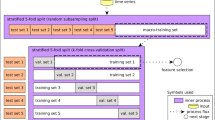Abstract
Historical Solar X-rays time series are employed to track solar activity and solar flares. High level of X-rays released during Solar Flares can interfere in telecommunication equipment operation. In this sense, it is important the development of computational methods to forecast Solar Flares analyzing the X-ray emissions. In this work, historical Solar X-rays time series sequences are employed to predict future Solar Flares using traditional classification algorithms. However, for large data sequences, the classification algorithms face the problem of “dimensionality curse”, where the algorithms performance and accuracy degrade with the increase in the sequence size. To deal with this problem, we proposed a method that employs feature selection to determine which time instants of a sequence should be considered by the mining process, reducing the processing time and increasing the accuracy of the mining process. Moreover, the proposed method also determines which are the antecedent time instants that most affect a future Solar Flare.
Access this chapter
Tax calculation will be finalised at checkout
Purchases are for personal use only
Similar content being viewed by others
References
Aha, D. W., Kibler, D., & Albert, M. K. (1991). Instance-based learning algorithms. Machine Learning, 6(1), 37–66.
Besnard, P., & Hanks, S. (1995). In: Proceedings of the Eleventh Conference on Uncertainty in artificial intelligence, Montreal, 18–20 Aug 1995. Morgan Kaufmann Publishers.
Bobra, M. G., & Couvidat, S. (2015). Solar flare prediction using SDO/HMI vector magnetic field data with a machine-learning algorithm. The Astrophysical Journal, 798(2), 135.
Fawcett, T. (2004). ROC graphs: Notes and practical considerations for researchers. Palo Alto, CA.: Technical Report HP Laboratories.
Gallagher, P. T., Moon, Y.-J., & Wang, H. (2002). Active-region monitoring and flare forecasting – I. Data processing and first results. Solar Physics, 209(1), 171–183.
Hall, M., Frank, E., Holmes, G., Pfahringer, B., Reutemann, P., & Witten, I. (2009). The WEKA data mining software: An update. SIGKDD Explorations, 11(1), 10–18.
Holte, R. C. (1993). Very simple classification rules perform well on most commonly used datasets. Machine Learning, 11(1), 63–90.
Kira, K., & Rendell, L. A. (1992). A practical approach to feature selection. In Proceedings of the Ninth International Workshop on Machine learning, College Park (pp. 249–256)
Li, R., & Zhu, J. (2013). Solar flare forecasting based on sequential sunspot data. Research in Astronomy and Astrophysics, 13(9), 1118–1126.
Maimon, O., & Rokach, L. (2010). Data mining and knowledge discovery handbook (2nd ed.). New York: Springer.
Quinlainn, J. R., & Ross, J. (1993). C4.5: Programs for machine learning. San Mateo: Morgan Kaufmann Publishers.
Ribeiro, M. X., Balan, A. G. R., Felipe, J. C., Traina, A. J. M., & Traina, C. (2009). Mining statistical association rules to select the most relevant medical image features. In Mining complex data (pp. 113–131). Berlin/Heidelberg: Springer.
Scholkopf, B., Burges, C. J. C., & Smola, A. J. (1999). Advances in kernel methods: Support vector learning. Cambridge: MIT Press.
Thijssen, J. M. (2007). Computational physics (2nd ed.). Cambridge: Cambridge University Press.
Yu, D., Huang, X., Wang, H., & Cui, Y. (2009). Short-term solar flare prediction using a sequential supervised learning method. Solar Physics, 255, 91–105.
Yu, D., Huang, X., Hu, Q., Zhou, R., Wang, H., & Cui, Y. (2010). Short-term solar flare prediction using multiresolution predictors. The Astrophysical Journal, 709(1), 321–326.
Author information
Authors and Affiliations
Corresponding author
Editor information
Editors and Affiliations
Rights and permissions
Copyright information
© 2018 Springer International Publishing AG
About this paper
Cite this paper
Junior, S.L.D., Cecatto, J.R., Fernandes, M.M., Ribeiro, M.X. (2018). An Optimized Data Mining Method to Support Solar Flare Forecast. In: Latifi, S. (eds) Information Technology - New Generations. Advances in Intelligent Systems and Computing, vol 558. Springer, Cham. https://doi.org/10.1007/978-3-319-54978-1_60
Download citation
DOI: https://doi.org/10.1007/978-3-319-54978-1_60
Published:
Publisher Name: Springer, Cham
Print ISBN: 978-3-319-54977-4
Online ISBN: 978-3-319-54978-1
eBook Packages: EngineeringEngineering (R0)




